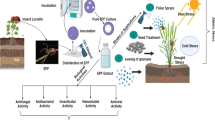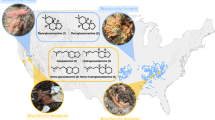Abstract
The exocrine glandular secretions of leaf beetle larvae of the taxon Chrysomela are well-known defensive devices used against some generalist predators. Salicylaldehyde is the major repellent component of secretions emitted by larvae of Chrysomela vigintipunctata and C. lapponica, which feed on salicin-rich Salicaceae. In this study, we examined whether salicylaldehyde is also active against the entomopathogenic fungus Metarhizium anisopliae. The germination and growth of this fungus was strongly inhibited when salicylaldehyde was applied directly onto the blastospores. The salicylaldehyde concentration of the larval secretions of the tested willow feeding Chrysomela larvae was much higher than the one necessary to display this antifungal activity. Additionally, salicylaldehyde was shown to reduce germination and growth of M. anisopliae via the gas phase over a distance of 45 mm. Further studies on the antimicrobial activity of the salicylaldehyde-containing secretions of Chrysomela larvae revealed that they act nonspecifically against prokaryotic (Escherichia coli) and eukaryotic cells (Saccharomyces cerevisiae and Trichoplusia ni). All antimicrobial and cytotoxic effects detected proved to be due to salicylaldehyde. The larval secretions of the birch-feeding allospecies of C. lapponica, that do not contain salicylaldehyde, but mainly carboxylic acids and their esters, showed no detectable effects on bacteria or fungi and no cytotoxic effects against insect cells. The results are discussed with respect to their ecological relevance.
Similar content being viewed by others
REFERENCES
Blum, M. S., Brand, J. M., Wallace, J. B., and Fales, H. M. 1972. Chemical characterisation of the defensive secretion of a chrysomelid larva. Life Sci. 11:525–531.
Brown, W. M. 1956. The new world species of Chrysomela L. (Coleoptera, Chrysomelidae). Can. Entomol. 88:3–54.
Falbe, J. and Regitz, M. 1991. Römpp Chemie Lexikon, 9 edn. Georg Thieme Verlag, Stuttgart.
Faye, I. and Wyatt, G. R. 1980. The synthesis of antibacterial proteins in isolated fat body from Cecropia silkmoth pupae. Experientia 36:1325–1326.
Garb, G. 1915. The eversible glands of a chrysomelid larva, Melasoma lapponica. J. Entomol. Zool. 7:87–97.
Gross, J. 1997. Speciation in the leaf beetle Chrysomela lapponica L.: Comparative studies in chemoecology, ethology and morphology of different stages of two allopatric populations [in German, with an English summary]. Sber. Ges. Naturf. Freunde Berlin 36:125–142.
Gross, J. and Hilker, M.1995. Chemoecological studies of the exocrine glandular larval secretions of two chrysomelid species (Coleoptera): Phaedon cochleariae and Chrysomela lapponica.Chemoecology 5/6: 185–189.
Gross, J., MÜller, C., Vilcinskas, A., and Hilker, M. 1998. Antimicrobial activity of the exocrine glandular secretions, hemolymph and larval regurgitate of the mustard leaf beetle Phaedon cochleariae. J. Invert. Pathol. 72:296–303.
Hilker, M. and Schulz, S. 1994. Composition of larval secretion of Chrysomela lapponica (Coleoptera, Chrysomelidae) and its dependence on host plant. J. Chem. Ecol. 20:1075–1093.
Hinton, H. E. 1951. On a little-known protective device of some chrysomelid pupae (Coleoptera).Proc. R. Entomol. Soc. London 26:67–73.
Humber, R. A. 1996. Fungal pathogens of the Chrysomelidae and prospects of their use in biological control, pp. 93–115, in P. H. Jolivet and M. L. Cox (eds.). Chrysomelidae Biology. SPB Academic Publishing, Amsterdam, The Netherlands.
Julkunen-Tiitto, R. 1986. A chemotaxonomic survey of phenolics in leaves of northern Salicaceae species. Phytochemistry 25: 663–667.
KÖpf, A., Rank, N. E., Roininen, H., and Tahvanainen, J. 1997. Defensive larval secretions of leaf beetles attract a specialist predator Parasyrphus nigritarsis. Ecol. Entomol. 22:176–183.
Letzner, K. 1876. Über die schlesischen Formen der Lina lapponica L., deren Lebensweise und ersten Stände. Jber. Schlesische Ges. Vaterländ. Kult. 53:170–175.
Matsuda, K. and Sugawara, F. 1980. Defensive secretion of chrysomelid larvae Chrysomela vigintipunctata costella (Marseul), C. populi L. and Gastrolina depressa Baly (Coleoptera: Chrysomelidae).Appl. Entomol. Zool. 15:316–320.
Mohrig, W. and Messner, B. 1968. Immunreaktionen bei Insekten. I. Lysozym als grundlegender antibakterieller Faktor im humoralen Abwehrmechanismus der Insekten. Biol. Zentralbl. 87:439–447.
Mosmann, T. 1983. Rapid colorimetric assay for cellular growth and survival: Application to proliferation and cytotoxicity assays. J. Immunol. Meth. 65:55–63.
Nahrstedt, A. 1990. Nutzung pflanzlicher Sekund¨arstoffe durch Tier und Mensch. Dtsch. Apoth. Ztg. 40:2155–2161.
Oldham, N. J., Veith, M., and Boland, W. 1996. Iridoid monoterpene biosynthesis in insects: Evidence for a de novo pathway occurring in the defensive glands of Phaedon armoraciae (Chrysomelidae) leaf beetle larvae. Naturwissenschaften 83:470–473.
Palokangas, P., Neuvonen, S., and Haapala, S. 1992. Effect of host plant growth and defence in two Phratora (Coleoptera: Chrysomelidae) species, pp. 343–344, in S. B. J. Menken, J. H. Visser, and P. Harrewijn (eds.). Proceedings of the 8th International Symposium on Insect-Plant Relationships. Kluwer Academic Publisher, Dordrecht, The Netherlands.
Pasteels, J. M. and Gregoire, J. C. 1984. Selective predation on chemically defended chrysomelid larvae. J. Chem. Ecol. 10: 1693–1700.
Pasteels, J. M., Braekman, J.-C., Daloze, D., and Ottinger, R. 1982. Chemical defence in chrysomelid larvae and adults. Tetrahedron 38: 1891–1897.
Pasteels, J. M., Rowell-Rahier, M., Braekman, J.-C., and Dupont, A. 1983. Salicin from host plant as precursor of salicylaldehyde in defensive secretion of chrysomeline larvae. Physiol. Entomol. 8:307–314.
Pasteels, J. M., Daloze, D., and Rowell-Rahier, M. 1986. Chemical defence in chrysomelid eggs and neonate larvae. Physiol. Entomol. 11:29–37.
Pasteels, J. M., Braekman, J.-C., and Daloze, D. 1988. Chemical defence in the Chrysomelidae, pp. 233–252, in P. H. Jolivet, E. Petitpierre, and T. H. Hsiao (eds.). Biology of Chrysomelidae.Kluwer Academic Publisher, Dordrecht, The Netherlands.
Rank, N. E. 1994. Host-plant effects on larval survival of a salicin-using leaf beetle Chrysomela aeneicollis Schaeffer (Coleoptera: Chrysomelidae). Oecologia 97:342–353.
Rank, N. E., Smiley, J. T., and KÖpf, A. 1996. Natural enemies and host plant relationships for chrysomeline leaf beetles feeding on Salicaceae, pp. 147–171, in P. H. Jolivet and M. L. Cox (eds.). Chrysomelidae Biology, Vol.2. SPB Academic Publ., Amsterdam, The Netherlands.
Rowell-Rahier, M. and Pasteels, J.M. 1986. Economics of chemical defense in Chrysomelinae. J. Chem. Ecol. 12:1189–1203.
Sachs, L. 1992. Angewandte Statistik, 7 ed. Springer Verlag, Berlin.
Sears, A. L. W., Smiley, J. T., Hilker, M., MÜller, F., and Rank, N. E. 2001. Nesting behavior and prey use in two geographically separated populations of the specialist wasp Symmorphus christatus (Vespidae: Eumeninae). Am. Midl. Nat. 145: 233–246. ANTIMICROBIAL ACTIVITY OF Chrysomela SECRETION 331
Soetens, P., Pasteels, J. M., Daloze, D., and Kaisin, M. 1998. Host plant influence on the composition of the defensive secretion of Chrysomela vigintipunctata larvae (Coleoptera: Chrysomelidae).Biochem. Syst. Ecol. 26:703–712.
Termonia, A. and Pasteels, J. M. 1999. Larval chemical defence and evolution of host shifts in Chrysomela leaf beetles. Chemoecology 9:13–23.
Termonia, A., Hsiao, T. H., Pasteels, J. M., and Milinkovitch, M. C. 2001. Feeding specialization and host-derived chemical defense in Chrysomeline leaf beetles did not lead to an evolutionary dead end. Proc. Natl. Acad. Sci. USA 96:3909–3914.
Vilcinskas, A. and Matha, V. 1997. Antimycotic activity of lysozyme and its contribution to antifungal humoral defence reactions in Galleria mellonella. Anim. Biol. 6:19–29.
Wallace, J. B. and Blum, M. S. 1969. Refined defensive mechanisms in Chrysomela scripta. Ann. Entomol. Soc. Am. 62:503–506.
Zvereva, E. L. and Kozlov, M. V. 2000. Effects of air pollution on natural enemies of the leaf beetle Melasoma lapponica. J. Appl. Ecol. 37:298–308.
Author information
Authors and Affiliations
Corresponding author
Rights and permissions
About this article
Cite this article
Gross, J., Podsiadlowski, L. & Hilker, M. Antimicrobial Activity of Exocrine Glandular Secretion of Chrysomela Larvae. J Chem Ecol 28, 317–331 (2002). https://doi.org/10.1023/A:1017934124650
Issue Date:
DOI: https://doi.org/10.1023/A:1017934124650




